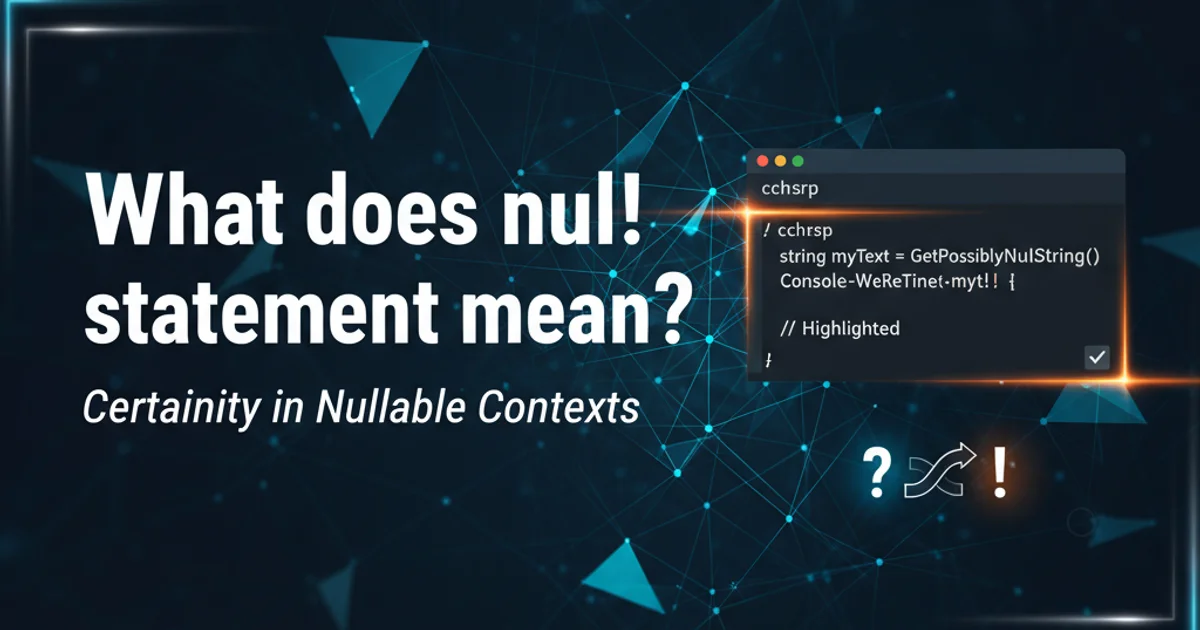What does null! statement mean?
Categories:
Understanding the null! Statement in C# 8.0 Nullable Reference Types

Explore the purpose and implications of the null! suppression operator in C# 8.0, a powerful tool for managing nullable reference types when you're certain a value won't be null.
C# 8.0 introduced Nullable Reference Types (NRTs) as a significant feature to help developers reduce NullReferenceException errors. This feature allows you to explicitly declare whether a reference type variable can hold a null value. While NRTs are excellent for compile-time null checking, there are scenarios where the compiler's analysis might be too conservative, or you, as the developer, have more information about the runtime state than the compiler. This is where the null! statement, also known as the null-forgiving operator or null suppression operator, comes into play.
What is the Null-Forgiving Operator (null!)?
The null! operator is a unary postfix operator that can be applied to any expression of a reference type. Its primary purpose is to tell the C# compiler, "I know this expression might be null according to your analysis, but I guarantee it won't be at runtime." Essentially, it suppresses any nullable warnings that the compiler might issue for that specific expression. It changes the nullable state of an expression from nullable to not-null without performing any runtime checks.
string? nullableString = GetPotentiallyNullString();
// Compiler warns about potential null dereference
// Console.WriteLine(nullableString.Length);
// Using null! to suppress the warning, asserting it's not null
Console.WriteLine(nullableString!.Length);
Basic usage of the null! operator to suppress a nullable warning.
When to Use null!
The null! operator should be used judiciously and only when you are absolutely certain that an expression will not evaluate to null at runtime, despite the compiler's static analysis. Common scenarios include:
- Initialization Logic: When a field or property is initialized in a constructor or helper method, but the compiler can't track this across different methods.
- ORM/Deserialization: When an Object-Relational Mapper (ORM) or deserializer guarantees that certain properties will be populated after an object is created, even if the constructor doesn't explicitly initialize them.
- Legacy Code Interop: When interacting with older codebases or libraries that haven't been updated for NRTs, and you know their behavior guarantees non-null values.
- Testing/Mocking: In unit tests, where you might intentionally mock a non-null scenario.
- Guaranteed by Context: When a value is known to be non-null due to external factors (e.g., a UI element that's always present, a configuration value that's always set).
flowchart TD
A[Code with potential null reference] --> B{Compiler Warning?}
B -- Yes --> C{Is value truly non-null at runtime?}
C -- Yes --> D[Apply `null!` operator]
D --> E[Suppress Warning]
C -- No --> F[Handle null explicitly (e.g., `if (x is not null)`) or redesign]
B -- No --> G[No action needed]Decision flow for when to use the null! operator.
public class User
{
public string Name { get; set; } = null!;
public User(string name)
{
Name = name;
}
public User() // Parameterless constructor for ORM/deserialization
{
// Name is initialized to null! here, assuming ORM will populate it.
// Without null!, compiler would warn that Name is uninitialized.
}
}
Using null! for properties expected to be initialized by an ORM or deserializer.
Risks and Best Practices
While null! can be useful, it effectively bypasses the compiler's null safety checks. Misusing it can reintroduce NullReferenceException errors that NRTs are designed to prevent. Therefore, it's crucial to use it with caution.
Best Practices:
- Minimize Usage: Only use
null!when absolutely necessary and when other solutions (like proper null checks, default values, or redesigning the code) are not feasible or overly complex. - Document Why: If you use
null!, add a comment explaining why you are certain the value will not be null. This helps future maintainers understand your intent. - Encapsulate: If a
null!is needed for an internal implementation detail, try to encapsulate it within a private method or property, exposing only null-safe APIs. - Consider Alternatives: Before reaching for
null!, consider alternatives like:- Providing a default non-null value.
- Throwing an
ArgumentNullExceptionif a parameter is unexpectedly null. - Using
if (value is not null)checks. - Refactoring code to ensure initialization happens before use.
null! operator performs no runtime checks. If your assertion that a value is non-null turns out to be incorrect, a NullReferenceException will occur at runtime, just as it would without NRTs enabled. It's a compile-time instruction, not a runtime safeguard.Interaction with default!
It's worth noting the distinction between null! and default!. While null! is specifically for reference types in nullable contexts, default! is used to get the default value of a type, suppressing warnings for non-nullable value types or non-nullable reference types. For example, int i = default!; would assign 0 to i without a warning, and string s = default!; would assign null to s without a warning, even if s is a non-nullable string. The null! operator, however, is about asserting a currently nullable expression is actually non-null.
string? maybeNull = null;
string definitelyNotNull = maybeNull!;
// At runtime, definitelyNotNull will be null, but compiler won't warn.
int x = default!;
// x is 0
string y = default!;
// y is null, but compiler won't warn even if 'string' is non-nullable context.
Comparing null! and default! behavior.
In summary, the null! operator is a powerful escape hatch in C# 8.0's nullable reference types feature. It allows developers to override the compiler's nullability analysis when they have superior knowledge of the runtime state. Use it sparingly, with clear justification, and always prioritize safer alternatives to maintain the integrity of your null-safe codebase.